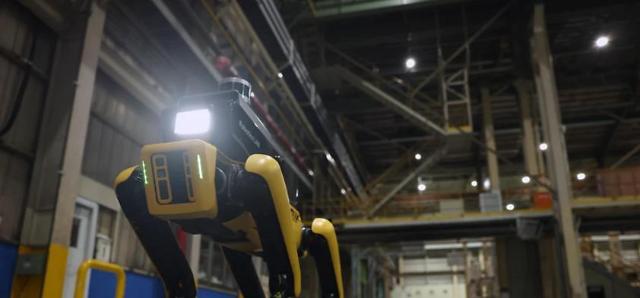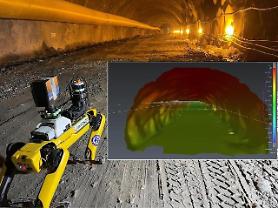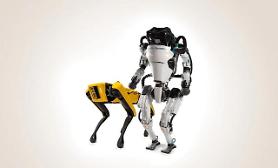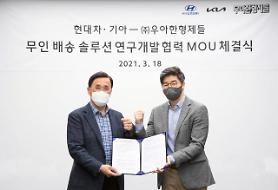
[Courtesy of Hyundai Motor]
SEOUL -- A dog-like safety service robot based on Spot, a four-legged robot developed by Boston Dynamics acquired by South Korea's Hyundai auto group, was deployed for pilot operation at an auto plant in South Korea. It is equipped with diverse technologies suitable for autonomous patrol services at industrial sites, including task management and deep learning-based vision technology.
The pilot operation was introduced at a plant run by Kia Motors, a subsidiary of the auto group, to assess its effectiveness and applicability before being deployed to other industrial sites. The auto group said the robot supports late-night security patrols and creates a safer environment for workers.
The robot was applied with artificial intelligence, autonomous navigation, teleoperation technologies, and computing payload for usage in various industrial tasks. "The Factory Safety Service Robot is the first collaboration project with Boston Dynamics. The Robot will help detect risks and secure people’s safety in industrial sites,” Hyun Dong-jin, head of the group's robotics lab, said in a statement on September 17.
With an integrated thermal camera and a 3D LiDAR light detection and ranging device, Hyundai said that the robot is able to detect persons around it, monitor high-temperature situations and potential fire hazards, and perceive whether a door is open or closed. It can be remote-controlled through a secure webpage that provides a live stream of its movements around the plant, enabling office personnel to remotely observe industrial areas.
AI technology allows the robot to detect dangers and send alarms to managers and provides real-time sharing of photos of on-site situations and an activity log with the control center as well as support a rapid response in the event of an emergency by sounding an alarm. Managers can switch to manual teleoperation whenever needed to conduct a closer look at important sites.
Multiple robots can be connected to the control system to simultaneously check various zones and each quadruped robot can navigate through narrow spaces as well as identify blind areas, said the auto group, which has acquired a controlling 80 percent stake in Boston Dynamics, to diversify its business portfolio into robotics and urban air mobility (UAM), an ecosystem covering personal air vehicles (PAVs) or flying cars.
Based on Spot, Hyundai revealed a leg-wheel robot called transforming intelligent ground excursion robot (TIGER) in February 2021. The robot that is about 0.8 meters (2.6 feet) was designed to navigate through challenging terrain using a sophisticated leg and wheel locomotion system and various sensors.
Four-legged robots or leg-wheel-type robots are being developed by global robot makers and tech companies for their versatility. Unlike their wheeled or tracked brothers, legged robots can move through extreme terrain including rocky boulders and narrow mountain trails. In cases of emergency, they can move faster in severe terrain conditions to carry heavy cargo or patients.
GS Engineering & Construction, a Seoul-based builder, used Spot to collect data at construction sites in 2020. In May 2021, POSCO E&C, a construction arm of South Korea's top steelmaker, deployed a legged robot based on Spot at its tunnel construction site to check for cracks and construction errors that could cause disastrous accidents. The autonomous robot was jointly tweaked to equip high-performance cameras and a LiDar system that measures distance by illuminating the target with laser light.
Copyright ⓒ Aju Press All rights reserved.



